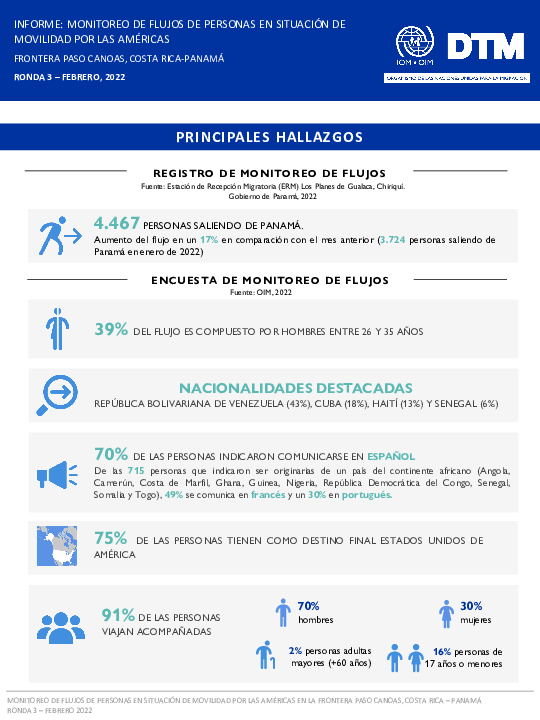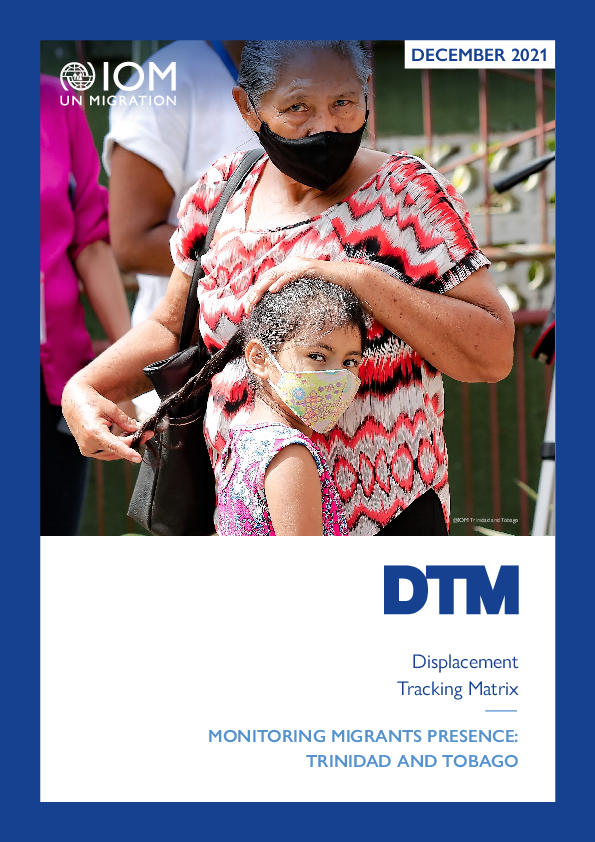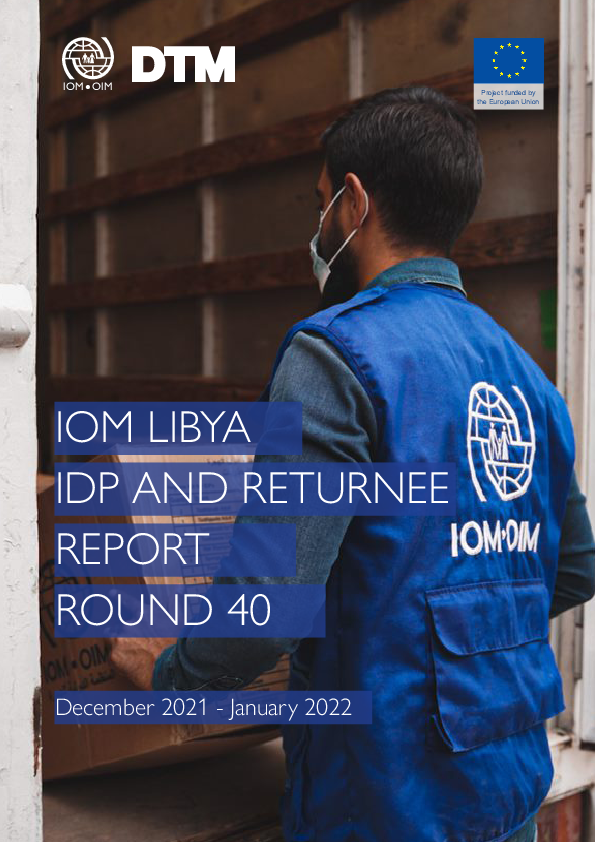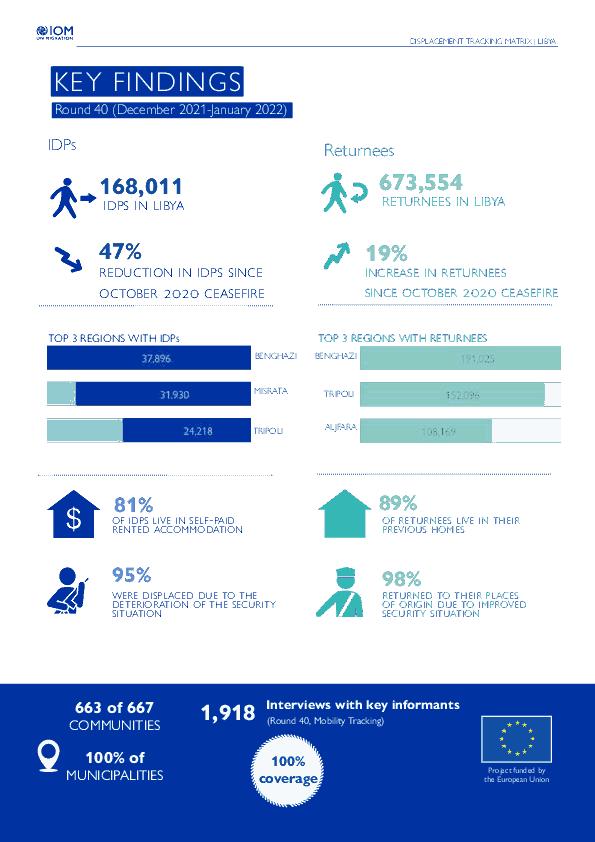-
Countries
-
Data and Analysis
-
Special Focus
-
Crisis Responses

Contact
DTMColombia@iom.int
Language
Spanish
Location
Colombia
Period Covered
Jul 01 2021
Dec 31 2021
Activity
- Flow Monitoring
- Mobility Tracking
Con el fin de monitorear los movimientos e identificar las necesidades de refugiados y migrantes venezolanos como insumo para diseñar una mejor respuesta, la Organización Internacional para las Migraciones (OIM) y el Grupo Interagencial sobre Flujos Migratorios Mixtos (GIFMM), han desarrollado desde julio de 2021 un ejercicio de monitoreo a través de analítica de WiFi , contando con 42 puntos localizados en diferentes departamentos, incluyendo aquellos ubicados en la frontera de Colombia con Venezuela (hacia el nororiente del país) y con Ecuador (suroccidente del país). El proyecto ha permitido beneficiar de manera directa a refugiados y migrantes que han accedido al servicio de internet, mientras que, paralelamente, se ha recolectado información que caracteriza el flujo y los perfiles de población en cada una de las regiones.
Este reporte analiza los resultados correspondientes al período comprendido entre el 18 de junio y el 31 de diciembre de 2021. Las cifras se presentan de forma desagregada para seis regiones delimitadas de acuerdo con las dinámicas históricas del flujo migratorio: región Central, región Caribe, región Caribe Norte, región Oriental, región Nororiental y región Sur, sobre las que se describen los principales hallazgos en términos de movimientos,

Contact
DTM Mozambique, DTMMozambique@iom.int
Language
English
Location
Mozambique
Period Covered
Mar 11 2022
Mar 12 2022
Activity
- Other
Cyclone Gombe made landfall as a Category 3 Tropical Cyclone on Friday, March 11 on the coast between Mossuril and Mogincual districts (Nampula Province). The most hit provinces are Nampula (Angoche, Moma, Mogovolas, Mucuburi, Monapo, Ilha, Lalaua, Mossuril, Nacala Porto and Meconta) and Zambezia (Namacurra, Gile, Nicoadala, Maganja, Pebane, Molocue, Mocubela, Mopeia, Mocuba and lle), leaving many houses and power lines destroyed with an estimated affected population of 115,336 individuals. Preliminary reports confirm the activation of 6 Accommodation Centres in Nampula.

Contact
DTMMozambique@iom.int
Language
English
Location
Mozambique
Period Covered
Mar 02 2022
Mar 08 2022
Activity
- Event Tracking
- Mobility Tracking
During the reporting period (2 to 8 March 2022), a total of 70 movements were recorded - 57 Arrivals (2,286 individuals), 2 transit (150 individuals) and 11 departures (584 individuals). The largest arrival movements were recorded in Nangade (1126 individuals), Mueda (300 individuals), Pemba (290 individuals), and Chiure (162 individuals). The largest departures were observed in Nampula (318 individuals), and Nangade (91 individuals). Of the total population, 46 per cent of the mobile groups were displaced for the first time, and 54 per cent of reported to having been displaced more than once prior to this movement.

Contact
Angelica Madrigal amadrigal@iom.int / Miranda Mora mmora@iom.int
Language
English
Location
Costa Rica
Period Covered
Feb 01 2022
Feb 28 2022
Activity
- Flow Monitoring
In the context of the COVID-19 emergency, since March 19, 2020, the Government of Costa Rica has kept its land border with Panama closed for the Binational Controlled Flow Operation, which sought an orderly and safe migration of migrants moving through the Americas3.
Given the presence of this irregular migration flow, since August 24, 2021, IOM Panama has published information on the irregular migration flow in Darién, Panama4 under the context of COVID-19, identifying that between August 2021 and January 2022, 93,139 migrants have entered Panama: Haiti (61%), Cuba (11%), Chile and Brazil with 7 percent, Bolivarian Republic of Venezuela (4%), among other countries of South America, Africa and Asia (10%).
In Costa Rica, during 2022, a steady increase in the number of migrants of this migration flow has been identified (it has increased by 20% compared to December 2021, when the monitoring of flows in Costa Rica began). In addition, according to data from the General Directorate of Migration and Foreigners (DGME), during May 2021 and February 2022, 4,976 rejections5 have been made in Paso Canoas.
In Costa Rica, there are many perceived vulnerabilities: people traveling alone, children, disoriented elderly people, people with medical problems, emotional exhaustion caused by stress, anguish and frustration. In addition, the main needs identified are associated with access to food, clothing, diapers, shelter, medicines and transportation. Many people have lost their identification documents and are reluctant to receive medical assistance, as they believe that they would not be allowed to continue their journey.

Contact
Angelica Madrigal amadrigal@iom.int / Miranda Mora mmora@iom.int
Language
Spanish
Location
Costa Rica
Period Covered
Feb 01 2022
Feb 28 2022
Activity
- Flow Monitoring
En el marco de la emergencia por la COVID-19, desde el 19 de marzo del 2020, el Gobierno de Costa Rica mantiene cerrada su frontera terrestre con Panamá para la Operación Binacional Flujo Controlado, la cual procuraba una migración ordenada y segura de personas migrantes en situación de movilidad por América3.
Ante la presencia de este flujo migratorio irregular, desde el 24 de agosto de 2021, OIM Panamá ha publicado información sobre el flujo migratorio irregular en Darién, Panamá4 bajo el contexto de la COVID-19, identificando que, desde agosto de 2021 y enero de 2022, han ingresado a Panamá 93.139 personas migrantes: Haití (61%), Cuba (11%), Chile y Brasil con 7%, República Bolivariana de Venezuela (4%), entre otros países del Sur de América, África y Asia (10%).
En Costa Rica, durante el 2022, se ha identificado un aumento constante en la cantidad de personas migrantes de este flujo migratorio (ha aumentado en un 20% en comparación con diciembre, 2021, cuando inició el monitoreo de flujos en Costa Rica). Además, de acuerdo con datos de la Dirección General de Migración y Extranjería (DGME), durante mayo de 2021 y febrero de 2022 se han realizaron 4.976 rechazos5 en Paso Canoas.
En Costa Rica se perciben muchas vulnerabilidades: personas viajando solas, niños y niñas, personas adultas mayores desorientadas, personas con problemas médicos, desgaste emocional ocasionado por estrés, angustia y frustración. Además, las principales necesidades detectadas se asocian con el acceso a alimento, ropa, pañales, alojamiento, medicamentos y transporte. Muchas personas han perdido sus documentos de identificación y se reúsan a recibir asistencia médica, pues consideran que no se les permitiría continuar con su viaje.

Contact
jali@iom.int
Language
English
Location
Trinidad & Tobago
Period Covered
Dec 01 2021
Dec 31 2021
Activity
- Survey
- Flow Monitoring Survey
Trinidad and Tobago, similar to many other countries, continues to wrestle with the worst impacts of the COVID-19 pandemic, which became manifest on the island in March 2020. This virus, however, presented another layer of complexity to an already complicated context. More pointedly, since 2016, the country has been grappling with escalating inflows of Venezuelan migrants, given the deteriorating situation in Venezuela. Additionally, from as early as 2014, it encountered significant economic challenges that were precipitated by plummeting energy commodity prices and sector contraction. Consequently, heightened health and safety protocols to combat the spread of the virus, such as the closure of national borders and non-essential businesses; the introduction of virtual school and work; and the declaration of a State of Emergency in May 2021; inadvertently exacerbated economic issues and migrant vulnerabilities.
IOM’s DTM is a system to track and monitor displacement and population mobility. It is designed to capture, process and disseminate critical multi-layered information on the mobility, vulnerabilities, and needs of displaced and mobile populations, regularly and systematically. Hence, the DTM provides decision-makers and responders with insightful data to guide specific assistance to target populations.
A total of 1,376 Venezuelan migrants participated in DTM 2021, between October and November 2021. The areas with the highest number of respondents were Penal/Debe followed by Chaguanas and Tunapuna/Piarco, as shown in Map 1. Notwithstanding this, three respondents indicated that they did not know in which Regional Corporation or district they resided. This may be due to a high level of internal mobility, amongst the Venezuelan migrant population, and resultant frequent changes in residence.

Contact
DTMcovid19@iom.int
Language
English
Location
Global
Snapshot Date
Mar 07 2022
Activity
- Other
The current outbreak of COVID-19 has affected global mobility in the form of various travel disruptions and restrictions. To better understand how COVID-19 affects global mobility, DTM has developed a COVID-19 database mapping the different restrictions to provide a global overview. For this, DTM uses the IATA site as the primary source of restrictions with the information reported per country and territory, and to the country of application.
Data collected includes:
- Date of restriction
- Country, territory or area of restriction
- Countries, territories or areas on which restrictions were imposed
- Type of restriction- total restriction, or conditional restriction – such as medical/ and or visa restriction
This DTM COVID-19 Travel Restrictions Output presents an analysis based on country imposing, the country being imposed upon, and the aggregation of the restriction type. The aim of the data analysis is to provide an overview of the COVID-19 outbreak on global mobility and to help identify and develop responses.

Contact
DTM Libya, DTMLibya@iom.int
Language
English
Location
Libya
Period Covered
Dec 01 2021
Jan 31 2022
Activity
- Mobility Tracking
- Baseline Assessment
This IOM Displacement Tracking Matrix (DTM) report presents the data and findings on internally displaced persons (IDPs) and returnees between December 2021 – January 2022, representing round 40 of the DTM Mobility Tracking in Libya. Consistent with the trend observed throughout 2021, in this round of reporting, the numbers of IDPs within the country continued decreasing, with a parallel increase in the number of returnees. As compared to 661,892 returnees identified in round 39, the number of those identified during round 40 increased to 673,554 individuals. This indicates a slight increase in the percentage of those returning (2%), accounting for a total increase of 19 per cent since October 2020 ceasefire in Libya.

Contact
DTM Libya, DTMLibya@iom.int
Language
English
Location
Libya
Period Covered
Dec 01 2021
Jan 31 2022
Activity
- Mobility Tracking
- Baseline Assessment
This infographic presents the key findings of Round 40 of the mobility tracking component of the Displacement Tracking Matrix (DTM) programme in Libya.
Contact
dtmlibya@iom.int
Location
Libya
Activity
- Mobility Tracking
- Baseline Assessment
Period Covered
Dec 01 2021 -Jan 31 2022
A baseline assessment is a sub-component of mobility tracking. It aims to collect data on IDP, migrant or returnee population presence in a defined administrative area of the country.
Population Groups
Survey Methodology
Unit of Analysis Or Observation
Type of Survey or Assessment
Keywords
Geographical Scope
Administrative boundaries with available data
The current dataset covers the following administrative boundaries
